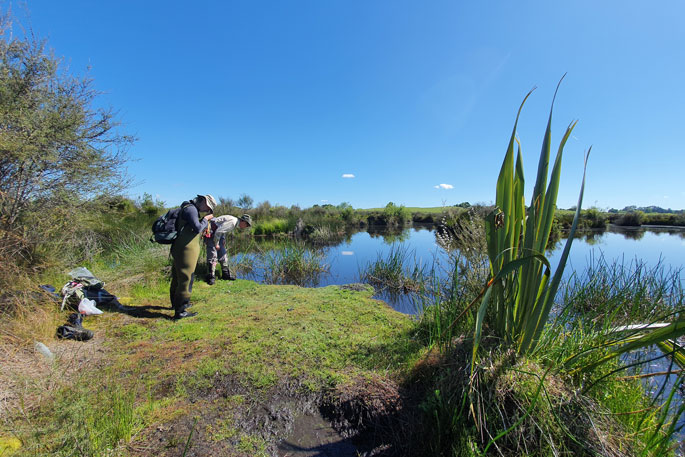A survey of rare plants has been completed at Waikato's internationally significant Whangamarino Wetland, with excitement over the rediscovery of a seldom-found carnivorous species.
It's been more than a decade since threatened plants have been surveyed at Whangamarino Wetland, with the last survey undertaken in 2009.
Covering almost 7000 ha in the Waikato, Whangamarino is the second largest freshwater wetland in the North Island and is one of three RAMSAR wetlands in the Department of Conservation's Hauraki-Waikato-Taranaki region.
Waikato District Biodiversity Rangers Lizzie Sharp and Kerry Jones, and plant expert Britta Deichmann, waded into the boggy wetland for 12 days between the months of September 2020 and April 2021, searching for botanical treasures.
'We were particularly excited when we found Utricularia australis or yellow bladderwort, an aquatic carnivorous plant,” says Lizzie Sharp.
'We had several ID books out and a lively debate about whether it was yellow bladderwort or the invasive weed Utricularia gibba or humped bladderwort.
The difference between the two plant species is the number of divisions in the leaves, and closer inspection by the team revealed it was yellow bladderwort, which is known only in the North Island.
'Yellow bladderwort was found at one site in the 2009 survey, and prior to that, at 11 sites based on historic data.
'By 2009, 10 of those sites had been infested with humped bladderwort, and as more than 10 years have passed since that survey, we expected the worst – that we would not find any specimens from this unusual and rare species.”
The survey requires each person to take turns making a pathway ahead while those following keep their eyes peeled for plants.
Travel through dense vegetation in boggy water is slow and physically challenging work, taking several hours to cover 1km.
'An average day out in the swamp had us wrap up in chest waders, safety glasses and gloves to protect us from ‘the stabber' (also known as Schoenus brevifolius, or zig-zag bog-rush) and other spiked wetland plants,” says Lizzie.
'If we spotted anything of interest, we would all huddle around with our field guides, magnifying lenses, cameras and notebooks.
'The common threats for all threatened plant species in Whangamarino are competition from encroaching weeds, drainage and decreasing habitat and, on occasion, collection by plant enthusiasts or botanists,” says Nigel Binks, Senior Biodiversity Ranger.
'This survey will help us make a plan as to what weed control we need to prioritise and which habitat types to protect to better manage plant population declines.”
The team also spotted a couple of matuku or Australasian bittern out in the swamp. Whangamarino Wetland is home to the threatened and elusive bird, which can be heard booming during early summer mornings. It is currently classified as 'threatened- nationally critically”, with less than 1000 in New Zealand.
The bog in the Whangamarino Wetland is treacherous and can be unpredictable, so visits by members of the public are discouraged.
'It's best not to venture too deep into the wetland,” says Lizzie.
'There are currently no tracks into the swamp, but the public is permitted on the Maramarua and Whangamarino Rivers and the Reao Stream.
'Driving around the periphery and looking beyond the band of invasive willow will give you a glimpse of the bog, peat and open water.”
Anyone near the wetland is encouraged to keep an eye out for weeds, and to clean any gear and boots before moving to a new site.
For more information about Whangamarino Wetland and its biodiversity, visit: https://www.doc.govt.nz/our-work/freshwater-restoration/arawai-kakariki-wetland-restoration/sites/whangamarino/about-whangamarino-wetland/



0 comments
Leave a Comment
You must be logged in to make a comment.